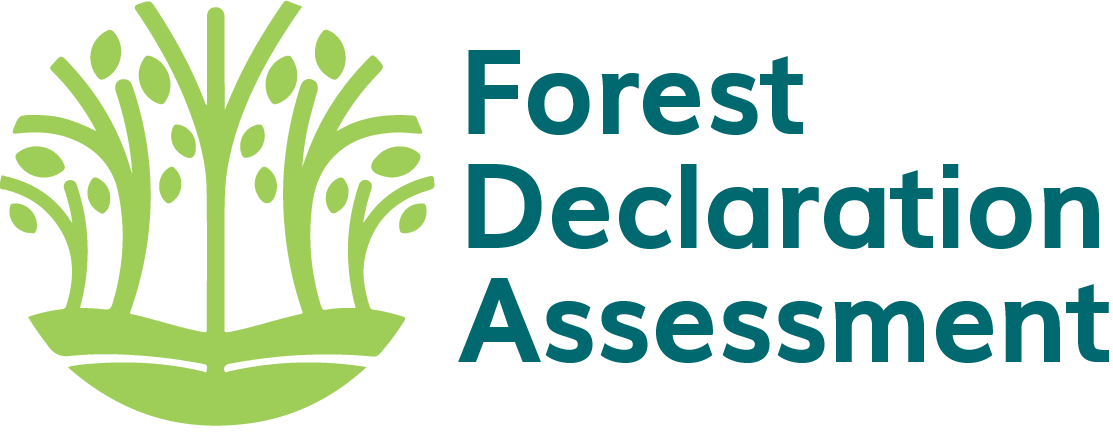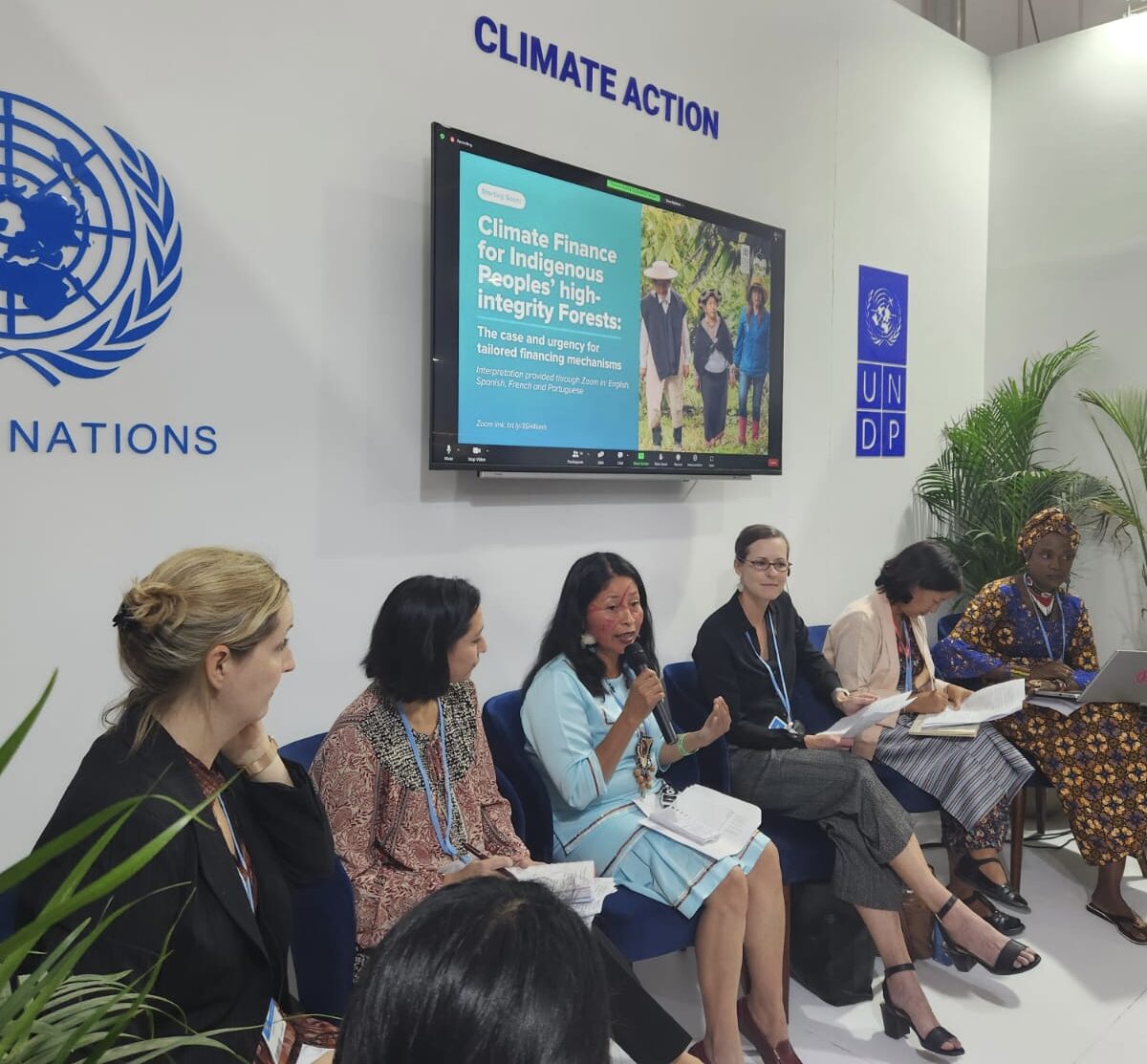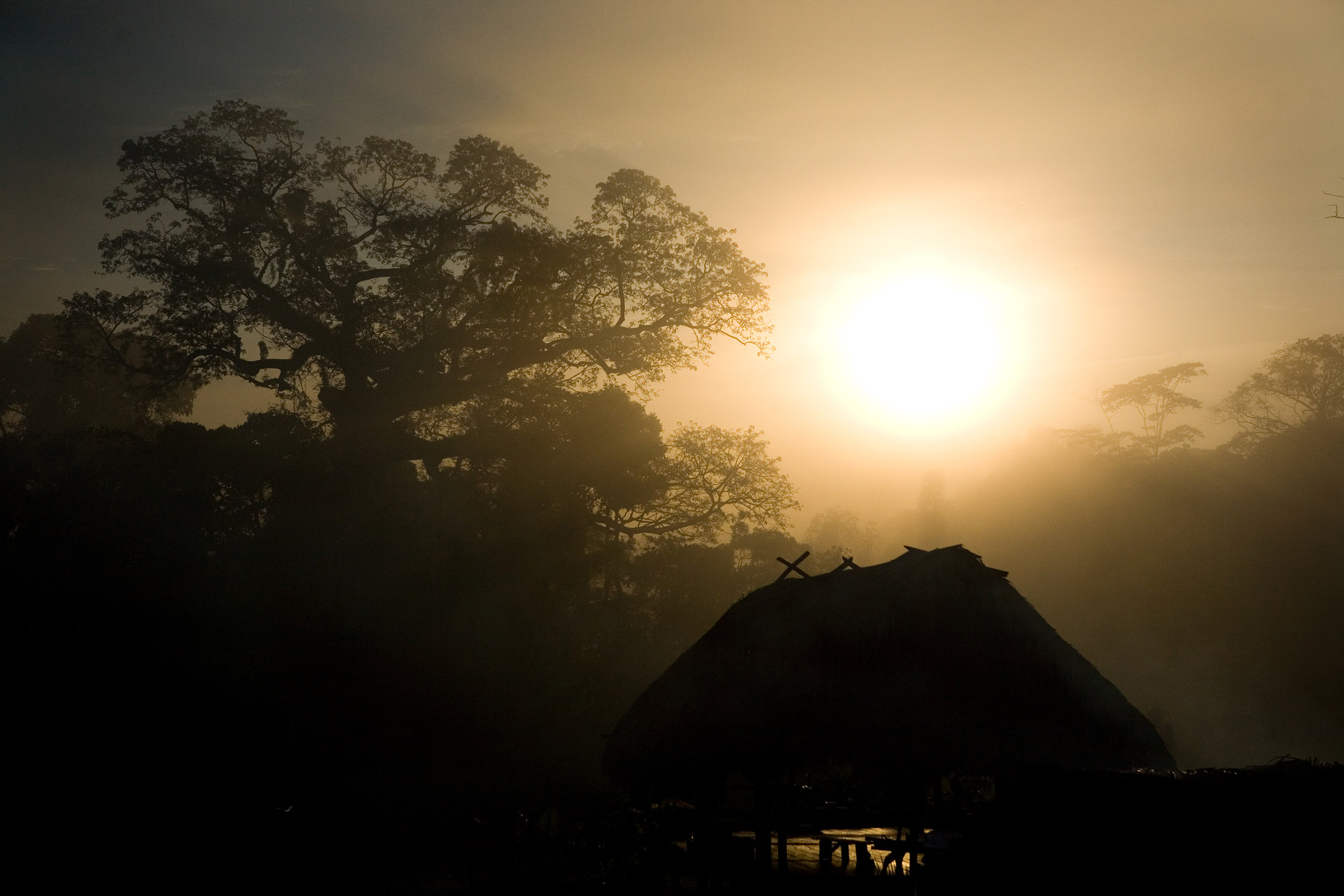The importance of Indigenous Peoples’ (IPs) and local communities’ (LCs) lands for climate change mitigation cannot be overstated.
Research consistently finds that IP and LC lands sequester carbon at higher rates than other managed lands. For example, 92% of forested IP and LC lands in Brazil, Colombia, Mexico, and Peru are net carbon sinks, with each hectare sequestering an average of 30 metric tons of carbon per hectare every year (Figure 1).1 On average, these lands sequestered more than twice as much carbon per hectare as lands not managed by IPs or LCs.2 By supporting IPs and LCs to better protect these lands, governments have a major opportunity to support enhanced sequestration and facilitate achievement of their NDCs.
Figure 1. Proportion of the area (ha) forested community and Indigenous lands that are carbon sinks or sources in Brazil, Colombia, Peru, and Mexico3
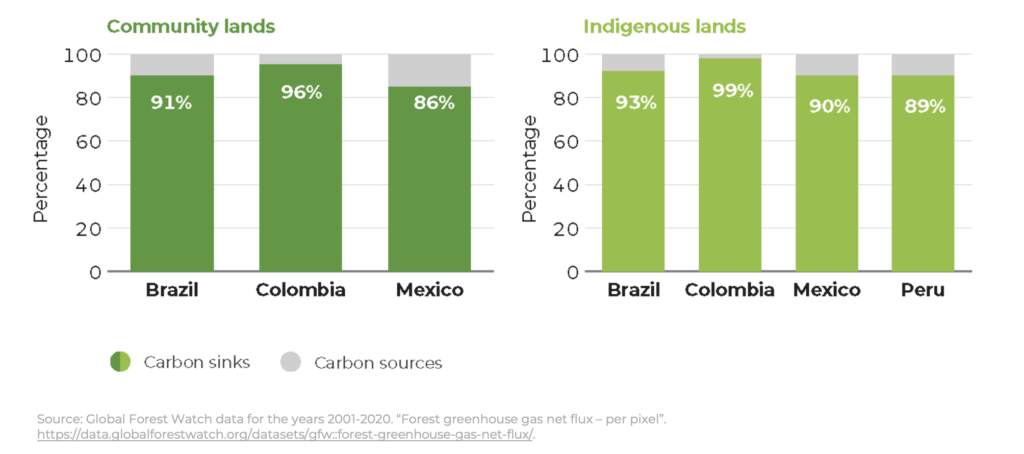
But the importance of investing in land tenure security for IPs and LCs spans far beyond just the carbon storage potential of the lands these communities manage.
While climate change mitigation is clearly essential, investing in the land tenure rights of IPs and LCs is equally a matter of human rights, social justice, local development, and a plethora of non-carbon environmental benefits. Research consistently shows that IPs and LCs manage ecosystems sustainably, act as agents of restoration, and protect against illegal and unsustainable deforestation. Evidence links community forest tenure with ecosystem benefits (e.g., water regulation, biodiversity protection); local economic development (e.g., job creation, or a redistribution of resources away from the need to advocate for land tenure); and greater social cohesion (e.g., reduced conflict over land rights) (Figure 2).
Accounting for at least 50% of the world’s land, Indigenous and community lands provide ecosystem services worth at least USD 1.16 trillion per year.4 Ensuring IPs and LCs have secure tenure rights is about much more than climate mitigation. When IPs and LCs have enforceable land rights, these communities can protect their cultural heritage, preserve biodiversity, improve local livelihoods, and manage resources in a manner. that meets their needs. It is essential that we look holistically at the importance of IP and LC land tenure rights.
Figure 2. Potential benefits associated with establishing and maintaining secure community forest tenure in Brazil and/or Guatemala
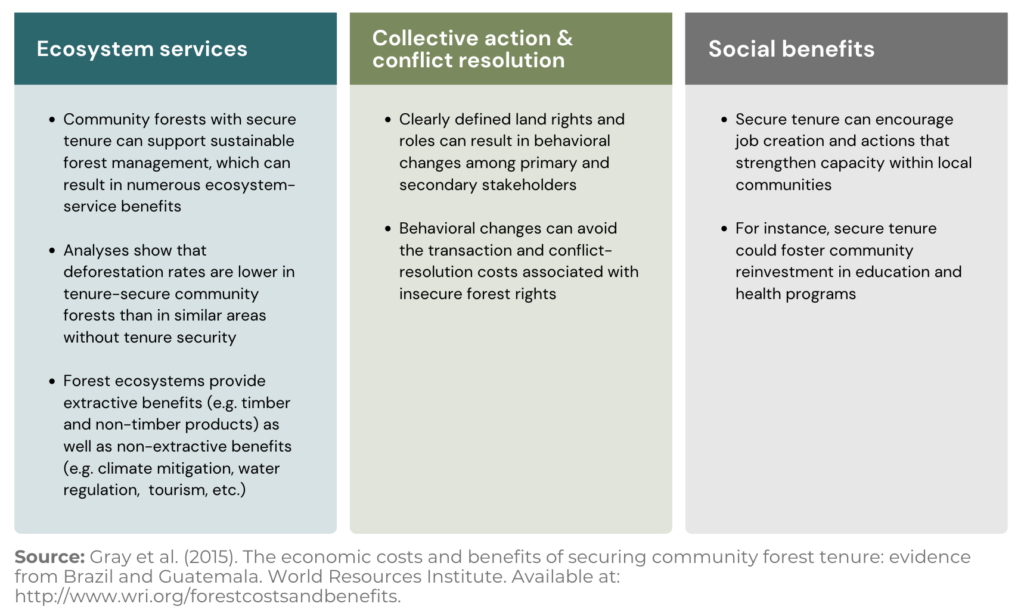
It’s clear that robust land tenure for IPs and LCs provides essential climate mitigation, ecosystem services, and myriad other non-carbon benefits. Still, these IPs and LCs receive vastly inadequate support to secure tenure rights and effectively manage their lands.
From the IPCC’s 2019 Special Report on Land to the 2014 New York Declaration on Forests and the COP26 IPLC Forest Tenure Joint Donor Statement, many major forest and climate initiatives have recognized the vital importance of IPs and LCs to the world’s climate and environmental goals. But this recognition is not yet backed up with sufficient finance to these communities.
Global finance needs for securing land rights for IPs and LCs to enable forest mitigation activities are estimated at USD 8.9 billion in total, equal to just over USD 315 million per year between 2022-50.5 However, IPs and LCs’ needs represent only 1.4 percent of the total public climate finance provided in 2019-20.6 Of the finance that has been directed towards IP and LC tenure and forest management (approximately USD 270 million per year from 2011 to 2020), only 11% went to projects that advanced tenure security – thereby meeting just 3 percent of the financial needs identified by the Rights and Resources Initiative for transformational tenure reform.7
On top of that, most funding funneled towards these activities first passes through larger intermediaries, posing a risk that only a small portion actually reaches the intended IP and LC beneficiaries. In fact, only 17% of donor projects explicitly mentioned the involvement of IPs and LCs in their implementation descriptions, per Rainforest Foundation Norway's analysis of donor transactions to IP and LC organizations.8
There are several ways that forest finance mechanisms can be improved to ensure that IPs and LCs receive sufficient finance to secure land tenure rights.
Public and private financial actors have the means to rapidly ramp up support for IPs and LCs land tenure rights. Financial actors – including governments, financial institutions, companies, and philanthropies – must:9
- Facilitate the flow of finance to IPs and LCs to better enable them to carry out forest-protection and conservation activities.
- Make every effort to support the involvement of IPs and LCs in forest and finance decision-making.
- Prioritize the establishment of new and direct finance mechanisms for forest activities and co-design these mechanisms with IP and LC groups.
- Increase coordination and cooperation between donors, NGOs, and IPs and LCs, which can help to build trust and inform the most appropriate, impactful interventions for these communities.
- Provide capacity building for IP and LC groups to receive and manage funds directly, while reducing administrative and technical burdens. Where financial intermediaries are necessary, organizations trusted by IPs and LCs should be prioritized.
IPs themselves have been acting to develop direct financial mechanisms to receive the funding they need. For example, the Shandia Vision – proposed by the Global Alliance of Territorial Communities (GATC) – is a platform under development that will support IPs and LCs in securing tenure rights, establishes a global ecosystem of community finance, channels climate finance to these communities through several regional mechanisms. Shandia serves as a platform to ensure direct finance for initiatives that combat climate change, land degradation, and protect biodiversity.
To read more on forest finance, forest governance, and IP and LC tenure rights, and related recommendations, check out the below resources:
- Sink or swim: How Indigenous and community lands can make or break nationally determined contributions (2022)
- Forest Declaration Assessment: Are we on track for 2030?
Featured image: On Mount Mantalingahan in the Philippines, where local communities harvest resin from almaciga (Agathis philippinensis) trees, the challenging access to the mountain and the restriction imposed by both the government and Indigenous communities contribute to the landscape’s conservation. Image by Keith Anthony Fabro for Mongabay.
Notes
- World Resources Institute & Climate Focus. (2022). Sink or swim: How Indigenous and community lands can make or break nationally determined contributions. Forest Declaration Assessment (publisher) & Climate Focus (coordinator and editor).
- World Resources Institute & Climate Focus. (2022).
- Data via Global Forest Watch, via World Resources Institute & Climate Focus. (2022).
- World Resources Institute & Climate Focus. (2022).
- This value covers the 24 countries that are ready for national- or medium-scale IPLC projects. See Rights and Resources Initiative (2021) Scaling-Up the Recognition of Indigenous and Community Land Rights: Opportunities, Costs and Climate Implications. https://rightsandresources.org/wp-content/uploads/2021/03/Scaling-Up-the-Recognition-of-IP-and-Community-Land-Rights-Opportunities-Costs-and-Climate-Implications-Final.pdf.
- Between 2019-2020, USD 632 billion in climate finance was provided globally. See Climate Policy Initiative (2021) Global Landscape of Climate Finance 2021. https://www.climatepolicyinitiative.org/publication/global-landscape-of-climate-finance-2021/.
- Rainforest Foundation Norway. (2021). Falling short: Donor funding for Indigenous Peoples and local communities to secure tenure rights and manage forests in tropical countries (2011–2020). https://d5i6is0eze552.cloudfront.net/documents/Publikasjoner/Andre-rapporter/RFN_Falling_short_2021.pdf.
- Rainforest Foundation Norway. (2021).
- Forest Declaration Assessment (2022). Finance for Forests: Theme 3 Assessment.
